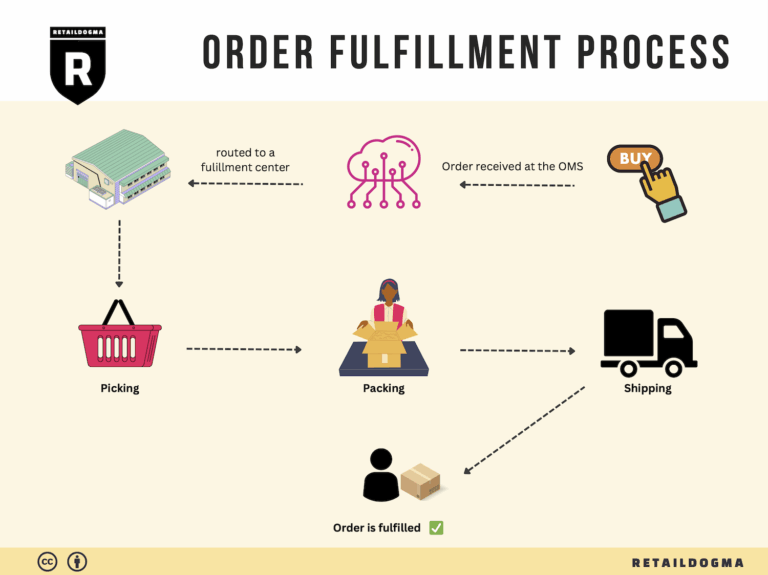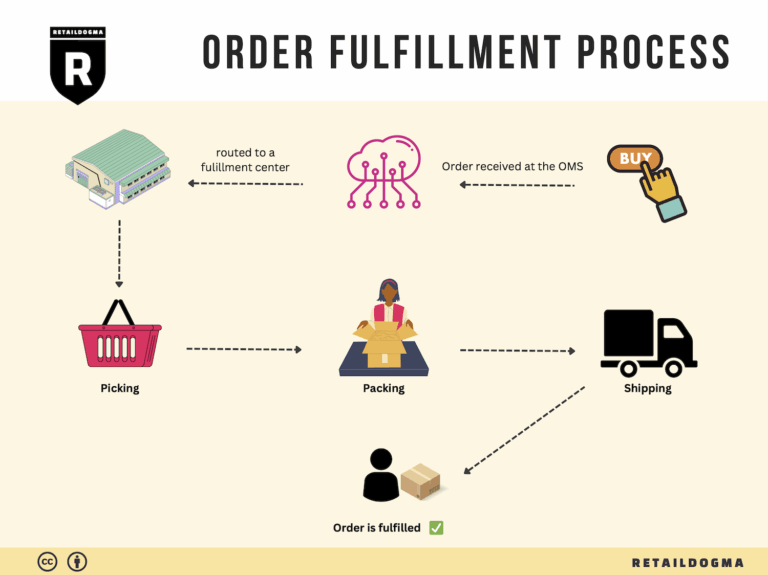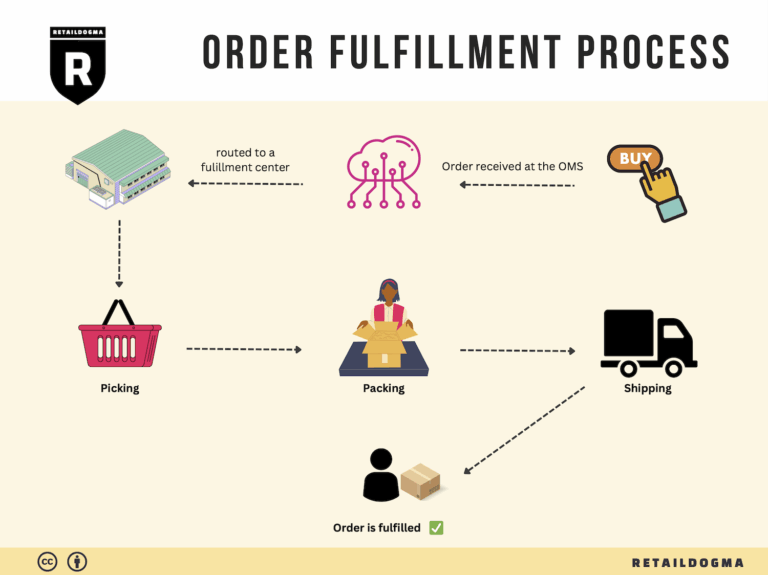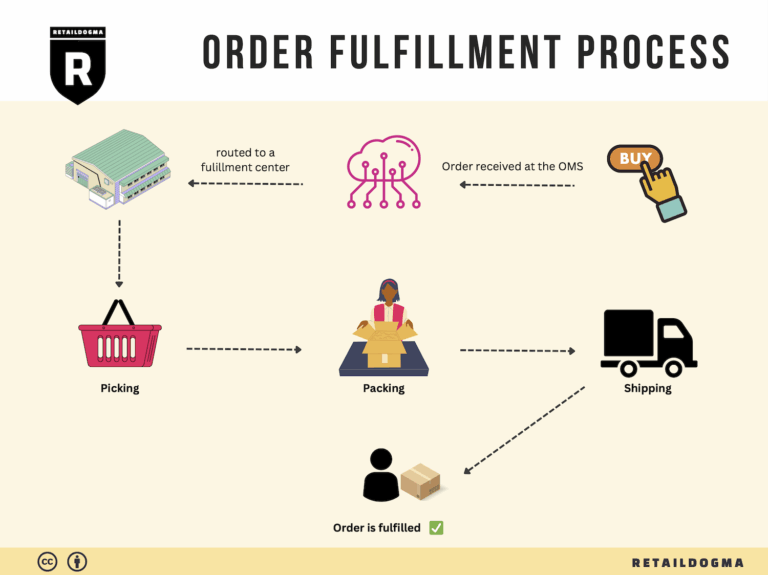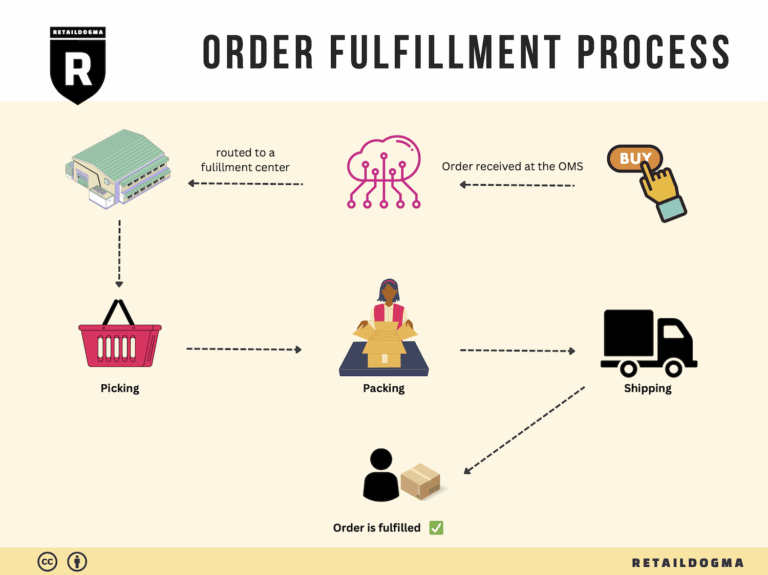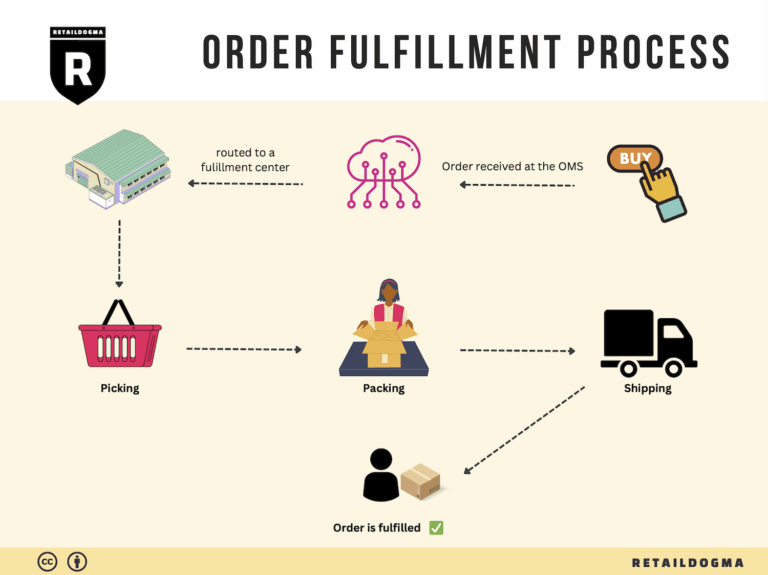How Order Fulfillment Works: A Step-by-Step Guide for Businesses
What is E-commerce Fulfillment? An Introduction for Growing Businesses
Understanding E-commerce Fulfillment
As an e-commerce business owner, you may find yourself overwhelmed by the myriad responsibilities that come with packing and shipping orders. From managing inventory to ensuring timely delivery, the logistics of getting products to your customers can quickly become a daunting task. This is where effective e-commerce fulfillment comes into play, serving as the backbone of your online operations.
Fulfillment can be simply defined as the process of getting a product from your inventory to your customer’s doorstep. This involves several stages, including order processing, picking, packing, shipping, and even handling returns. For growing businesses, mastering this process is crucial, as it directly impacts customer satisfaction and your overall operational efficiency.
In this guide, we will explore the various models of e-commerce fulfillment available to you, including Third-Party Logistics (3PL) and Fulfillment by Amazon (FBA). Understanding these models will help you determine which approach aligns best with your business goals. We will also delve into the core services that these fulfillment partners offer, such as inventory management, order tracking, and customer service support.
Choosing the right fulfillment partner is a critical decision that can influence your business’s scalability and profitability. We will provide practical advice on how to assess potential partners based on factors such as technology integration, service offerings, and geographic coverage. Additionally, we’ll discuss pricing structures, enabling you to understand the cost implications of various fulfillment options and how they fit within your budget.
The goal of this guide is to empower you with the knowledge and tools necessary to make informed decisions about your logistics strategy. By understanding the nuances of e-commerce fulfillment, you can streamline your operations, enhance customer experiences, and ultimately drive growth for your business. Whether you’re just starting out or looking to scale, effective fulfillment is key to your success in the competitive world of online retail.
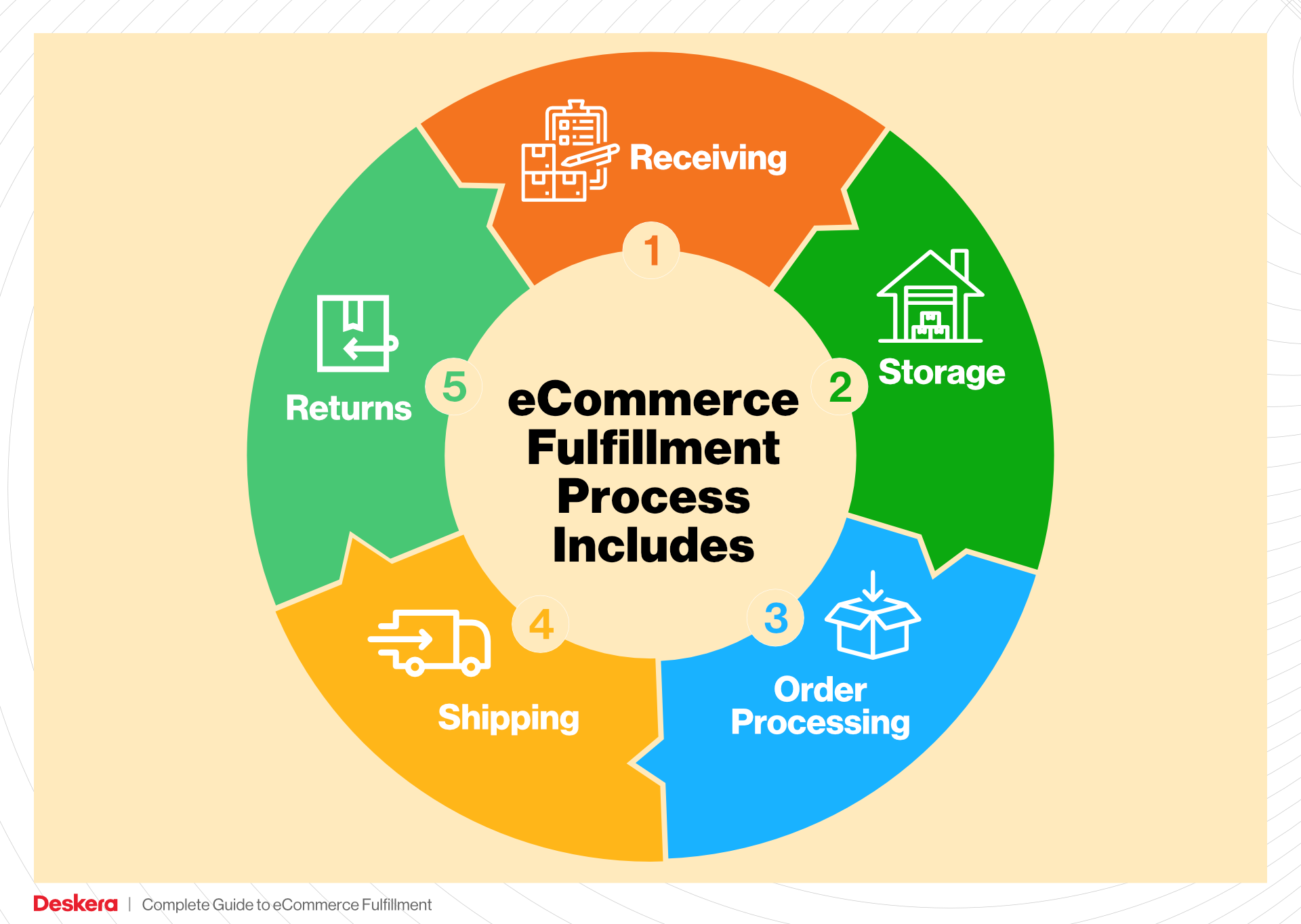
What You’ll Learn In This Guide
- What is E-commerce Fulfillment? An Introduction for Growing Businesses
- The Order Fulfillment Process: From ‘Buy’ Button to Customer’s Door
- Comparing Fulfillment Models: In-House vs. 3PL vs. Dropshipping
- A Deep Dive into Amazon FBA: Pros, Cons, and Who It’s For
- Core Services Offered by Fulfillment Centers
- How to Choose a Fulfillment Partner: A 6-Point Checklist
- Understanding Fulfillment Pricing: A Breakdown of Common Fees
- Frequently Asked Questions (FAQs) about Fulfillment
- Conclusion: Is Outsourcing Fulfillment the Right Move for Your Business?
- Important Disclaimer
The Order Fulfillment Process: From ‘Buy’ Button to Customer’s Door
1. Receiving Inventory
The order fulfillment process begins with receiving inventory at the fulfillment center. Upon arrival, shipments are verified against purchase orders to ensure accuracy. Each item is checked for quality and quantity, and any discrepancies are documented. This step is crucial as it sets the foundation for the entire fulfillment process. Proper inventory management ensures that the right products are available to meet customer demand, which minimizes stockouts and overstock situations.
A key term associated with this step is SKU (Stock Keeping Unit). Each product is assigned a unique SKU, which helps in tracking inventory levels and managing stock efficiently. For e-commerce businesses, maintaining accurate SKUs is vital as it allows for seamless integration with inventory management systems and helps prevent errors in order processing.
2. Warehouse Storage
Once inventory has been received and verified, products are moved to designated storage locations within the warehouse. This step involves organizing items in a manner that optimizes space and accessibility. Efficient warehouse storage systems often use methods like FIFO (First In, First Out) or LIFO (Last In, First Out) to manage inventory turnover effectively.
The importance of this step lies in its impact on order fulfillment speed and accuracy. Well-organized storage reduces the time it takes to locate items, which is essential for maintaining high service levels. A key term to understand here is bin locations; these are specific areas within the warehouse where items are stored. Clear bin labeling and organization help warehouse staff quickly find products when orders come in, thus improving overall operational efficiency.
3. Order Picking
Order picking is the process of retrieving items from storage to fulfill customer orders. When an order is placed, a pick list is generated, detailing the items and their corresponding bin locations. Warehouse associates then use this list to gather the necessary products, which may involve walking or using automated systems like conveyor belts or robots.
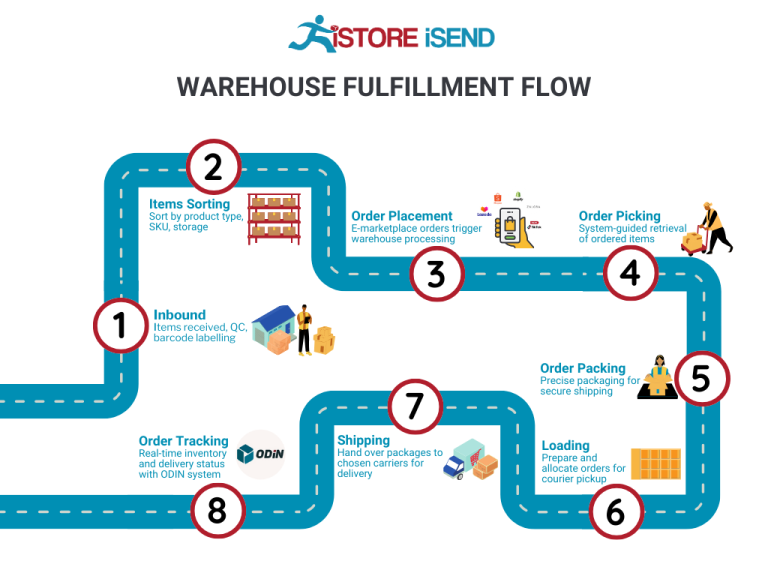
This step is critical as it directly affects order accuracy and customer satisfaction. Mistakes during picking can lead to incorrect orders, resulting in returns and dissatisfied customers. A relevant key term in this context is pick-to-light systems, which guide workers to the correct items using illuminated indicators, thereby enhancing picking speed and reducing errors.
4. Order Packing
After items have been picked, they are brought to the packing area where they are prepared for shipment. This involves checking the picked items against the order details to ensure accuracy, followed by securely packaging the products to prevent damage during transit. Proper packing techniques, including the use of appropriate packing materials and box sizes, are crucial to safeguarding items.
The significance of this step cannot be understated, as effective packing enhances the customer experience and reduces the likelihood of returns due to damage. A key term here is packing slips, which are documents included in the shipment that provide customers with details about their order. These slips not only serve as a receipt but also help customers verify that they have received the correct items.
5. Shipping & Delivery
The final step in the order fulfillment process is shipping and delivery. Once packages are packed, they are labeled and handed over to shipping carriers for delivery to customers. This step involves selecting the most efficient shipping method based on factors like cost, speed, and destination. Businesses often utilize multiple carriers to provide flexible options for customers.
The importance of shipping and delivery lies in its impact on customer satisfaction and retention. Timely and reliable delivery can significantly enhance the shopping experience and encourage repeat purchases. A key term associated with this step is tracking numbers, which provide customers with real-time updates on the status of their shipments. By offering tracking information, businesses can improve transparency and build trust with their customers, ultimately leading to increased loyalty.
In conclusion, understanding and optimizing each step of the order fulfillment process—from receiving inventory to shipping and delivery—is vital for e-commerce businesses looking to scale. By focusing on efficiency, accuracy, and customer satisfaction, companies can enhance their operational performance and drive growth in a competitive marketplace.
Comparing Fulfillment Models: In-House vs. 3PL vs. Dropshipping
Comparison of Fulfillment Models
| Model | Who Handles Inventory | Best For (Business Stage) | Key Advantage | Key Disadvantage |
|---|---|---|---|---|
| In-House Fulfillment | Business itself | Established businesses | Full control over inventory | High overhead costs and complexity |
| Third-Party Logistics (3PL) | Third-party provider | Growing businesses | Scalability and flexibility | Less control over inventory |
| Dropshipping | Supplier | Startups and small businesses | Low upfront investment | Lower profit margins and quality control issues |
In-House Fulfillment
In-house fulfillment involves managing the entire logistics process internally. This model requires businesses to handle their own inventory, storage, packing, and shipping. For established companies that have the resources and infrastructure, in-house fulfillment offers the advantage of complete control over the inventory, which allows for tailored customer experiences, better quality assurance, and direct oversight of the fulfillment process. This can lead to improved customer satisfaction, as businesses can quickly respond to issues and manage returns more effectively. However, the downside is that in-house fulfillment often incurs high overhead costs due to warehousing, staffing, and technology investments. Additionally, as order volumes increase, the complexity of operations can grow, making it challenging for businesses to scale efficiently without significant additional investments.
Third-Party Logistics (3PL)
Third-party logistics (3PL) providers offer outsourced logistics services, including warehousing, fulfillment, and distribution. In this model, the business relies on a third-party provider to manage its inventory and shipping processes. This approach is particularly beneficial for growing businesses that may not have the resources to invest heavily in their own logistics infrastructure. The key advantage of 3PL is its scalability; businesses can easily adjust their logistics needs based on demand fluctuations without the burden of maintaining a large warehouse or staffing levels. Furthermore, 3PL providers often have established relationships with carriers, which can lead to better shipping rates and more efficient distribution. However, businesses lose some control over their inventory and fulfillment processes, which can lead to challenges in quality assurance and customer service. Additionally, relying on a 3PL can sometimes result in hidden costs, especially if the partnership is not managed closely.
Dropshipping
Dropshipping is a fulfillment model where the retailer does not keep goods in stock but instead transfers customer orders directly to the supplier or manufacturer, who then ships the products directly to the customer. This model is particularly appealing for startups and small businesses looking to enter the e-commerce space without significant upfront investment in inventory. The primary advantage of dropshipping is the low financial risk, as businesses only pay for goods after a sale has been made. This allows entrepreneurs to test various products without the need for large inventory commitments. However, dropshipping also has notable disadvantages, including lower profit margins due to reliance on suppliers and potential quality control issues, as the retailer has no direct oversight of the product before it reaches the customer. Additionally, the fulfillment process can be slower, leading to potential customer dissatisfaction if suppliers do not meet shipping expectations.
Conclusion
Choosing the right fulfillment model depends significantly on the stage of your business, available resources, and long-term goals. In-house fulfillment offers control and customization but at a higher operational cost. Third-party logistics provides scalability and expertise but may reduce oversight of inventory. Dropshipping lowers upfront investment risk but can lead to challenges in profit margins and quality assurance. Understanding these models will enable e-commerce business owners to make informed decisions that align with their operational strategies and growth aspirations.
A Deep Dive into Amazon FBA: Pros, Cons, and Who It’s For
Understanding Fulfillment by Amazon (FBA)
Fulfillment by Amazon (FBA) is a service provided by Amazon that allows sellers to store their products in Amazon’s fulfillment centers. Amazon then takes care of storage, packaging, and shipping of these products directly to customers. This service is designed to simplify the logistics of e-commerce for sellers, enabling them to focus on growing their business while leveraging Amazon’s robust infrastructure.
How FBA Works
-
Product Listing: Sellers create a product listing on Amazon and indicate that they will use FBA for fulfillment.
-
Inventory Shipment: Sellers send their products to Amazon’s designated fulfillment centers. The inventory can be sent in bulk, and Amazon provides guidelines on how to prepare and package the items.
-
Storage: Once the products arrive, they are stored in Amazon’s warehouses until an order is placed.
-
Order Processing: When a customer places an order for a product fulfilled by FBA, Amazon picks, packs, and ships the product on behalf of the seller.

-
Customer Service: Amazon also manages customer service and returns for FBA orders, ensuring that customers receive a high level of service.
-
Fees: Sellers pay fees for storage and fulfillment, which can vary based on the size and weight of the product.
Pros of FBA
1. Prime Eligibility
Products fulfilled by Amazon are automatically eligible for Amazon Prime, which can significantly increase sales. Prime members are more likely to purchase products that offer free two-day shipping, which enhances visibility and sales potential.
2. Customer Trust
Amazon has built a reputation for reliability and excellent customer service. By using FBA, sellers can leverage this trust, as customers are more inclined to buy from listings that indicate fulfillment by Amazon. This can lead to higher conversion rates compared to sellers who fulfill orders themselves.
3. Multi-Channel Fulfillment
FBA is not limited to sales made on Amazon. Sellers can use FBA to fulfill orders from their own websites or other platforms, allowing for a streamlined logistics process across multiple sales channels. This flexibility can enhance operational efficiency and customer satisfaction.
4. Scalability
FBA allows sellers to scale their business without the need to invest heavily in logistics and warehousing. As demand increases, sellers can send more inventory to Amazon without worrying about the complexities of managing fulfillment.
5. Time-Saving
FBA handles the logistics of order fulfillment, which saves sellers time and allows them to focus on other aspects of their business, such as marketing and product development.
Cons of FBA
1. High Fees
While FBA offers convenience, it comes at a cost. Sellers must pay monthly storage fees based on the volume of their inventory and fulfillment fees for each item sold. These costs can accumulate and significantly impact profit margins, especially for low-cost items.
2. Strict Inventory Rules
Amazon has strict guidelines regarding inventory management. Sellers must regularly monitor their inventory levels to avoid excess storage fees or stockouts. Additionally, Amazon may remove or dispose of unsold inventory after a certain period, which can lead to losses.
3. Commingling Risks
FBA allows for the commingling of inventory, meaning that products from different sellers may be stored together. This can pose risks if a seller’s product is inadvertently mixed with defective or counterfeit items from another seller, potentially damaging their reputation.
4. Limited Control Over Fulfillment
Sellers relinquish control over the fulfillment process, which means they cannot customize packaging or shipping methods. This can be a disadvantage for brands that want to create a unique customer experience through their packaging.
5. Dependency on Amazon
Utilizing FBA creates a dependency on Amazon’s platform and policies. Changes in Amazon’s fees, policies, or algorithms can directly affect a seller’s business, making it essential to stay informed and adaptable.
Who is FBA Best For?
FBA is particularly beneficial for:
-
Small to Medium-Sized Businesses: Sellers looking to scale without investing in their own warehousing and logistics will find FBA an appealing option. It allows them to focus on sales and marketing while Amazon handles fulfillment.
-
E-commerce Entrepreneurs: Those just starting in e-commerce can take advantage of FBA’s infrastructure to streamline their operations and reach a broader customer base.
-
Brands with High Turnover Products: Sellers with products that have high demand and turnover rates can benefit from FBA’s efficient logistics, ensuring quick shipping times and maintaining customer satisfaction.
-
Multi-Channel Sellers: Businesses that sell across various platforms can use FBA to simplify their fulfillment process and maintain consistent service levels.
In conclusion, Fulfillment by Amazon offers a robust solution for e-commerce sellers looking to optimize their logistics and scale their operations. However, potential users should carefully consider the associated costs and risks, ensuring that FBA aligns with their business model and growth strategy. By understanding both the advantages and disadvantages, sellers can make informed decisions that best suit their operational needs and goals.
Core Services Offered by Fulfillment Centers
Inventory Management & Warehousing
Effective inventory management is a cornerstone of e-commerce success, and fulfillment centers excel in this area. They offer sophisticated warehousing solutions that allow businesses to store their products in strategically located facilities. These centers utilize advanced technology and software to monitor stock levels, track inventory movements, and forecast demand.
The primary benefit of robust inventory management is the reduction of carrying costs. By optimizing stock levels and ensuring that items are stored efficiently, fulfillment centers help businesses minimize waste and avoid overstock situations. Additionally, real-time inventory tracking allows for better decision-making regarding reordering and stock replenishment, ensuring that businesses can meet customer demand without delay. This capability is especially vital for e-commerce businesses that operate on a just-in-time basis, where having the right product available at the right time can significantly impact customer satisfaction and sales.
Pick and Pack Services
Pick and pack services are integral to the fulfillment process, where orders are assembled for shipping. Fulfillment centers employ systematic methods to pick items from their inventory based on customer orders, followed by packing these items securely for shipment. This process can involve various techniques, such as batch picking, zone picking, or wave picking, depending on the volume and variety of orders.
The main advantage of efficient pick and pack services is the speed and accuracy with which orders are fulfilled. By leveraging technology, such as barcode scanners and automated systems, fulfillment centers can significantly reduce picking errors and processing times. This not only enhances operational efficiency but also boosts customer satisfaction by ensuring that orders are delivered correctly and on time. For e-commerce businesses, where competition is fierce, the ability to fulfill orders quickly can be a significant differentiator.
Kitting and Assembly
Kitting and assembly services involve combining multiple products into a single package or preparing items for sale as a set. This service is particularly beneficial for businesses that sell items that are frequently purchased together or require assembly before they can be sold. Fulfillment centers can handle the entire kitting process, from sourcing the components to assembling them and packaging them for shipping.
The benefits of kitting and assembly services are manifold. First, they allow businesses to create unique product offerings that can enhance sales. For example, a business may offer a bundled product that includes complementary items at a discounted rate, encouraging customers to purchase more. Additionally, outsourcing these tasks to fulfillment centers frees up internal resources, allowing businesses to focus on core competencies like marketing and product development. Moreover, kitting can streamline shipping processes, as bundled products can often be shipped in a single package, reducing shipping costs and improving delivery times.
Returns Management (Reverse Logistics)
Returns management, or reverse logistics, is a critical service offered by fulfillment centers, particularly in the e-commerce sector, where return rates can be significantly higher than in traditional retail. Fulfillment centers provide a systematic approach to handling returns, from receiving returned items to inspecting and restocking them or processing them for disposal or recycling.
The benefit of an effective returns management system cannot be overstated. It enhances customer satisfaction by making the return process seamless and hassle-free, which is crucial for building trust and loyalty in e-commerce. A well-managed returns process can lead to higher customer retention rates, as customers are more likely to shop again if they know they can return items easily. Furthermore, efficient reverse logistics can help businesses recover value from returned products, whether through restocking, refurbishing, or recycling, thus minimizing losses associated with returns.
In conclusion, leveraging the core services of fulfillment centers can significantly enhance the operational efficiency of e-commerce businesses. From inventory management to returns handling, these services not only streamline logistics but also improve customer experience, ultimately driving growth and profitability. As e-commerce continues to evolve, partnering with a reliable fulfillment center becomes increasingly essential for businesses looking to scale effectively.
How to Choose a Fulfillment Partner: A 6-Point Checklist
Location & Warehouse Network
Importance:
The geographical location of your fulfillment partner is crucial for minimizing shipping times and costs. A partner with strategically located warehouses can ensure faster delivery to your customers, which is essential in today’s competitive e-commerce landscape.
Questions to Ask:
– Where are your fulfillment centers located, and how does this align with my target market?
– Can you provide insights on your shipping capabilities to various regions?
– How do you manage inventory across multiple locations to ensure stock availability?
Technology & Integrations
Importance:
In a technology-driven market, your fulfillment partner must have robust systems that integrate seamlessly with your e-commerce platform. This ensures real-time inventory tracking, order processing, and data analytics, which are vital for operational efficiency.
Questions to Ask:
– What technology do you use for order management and inventory tracking?
– Can your systems integrate with my e-commerce platform (e.g., Shopify, WooCommerce)?
– How do you handle data security and customer privacy in your technological processes?
Specializations (e.g., Cold Storage, Oversized Items)
Importance:
Depending on your product range, you may need a partner that specializes in handling specific types of goods, such as perishables requiring cold storage or oversized items that need special handling. Choosing a partner with the right capabilities can prevent damage and ensure compliance with regulations.
Questions to Ask:
– Do you have specialized facilities for my product type (e.g., cold storage, hazardous materials)?
– What experience do you have in handling products similar to mine?
– How do you ensure compliance with relevant regulations for specialized storage and shipping?
Scalability & Capacity
Importance:
As your business grows, your fulfillment needs will evolve. A partner that can scale with your business is essential to avoid disruptions in service during peak seasons or when launching new products.
Questions to Ask:
– What is your current capacity, and how do you manage peak seasons?
– Can you provide a plan for scaling operations if my order volume increases?
– How do you handle overflow and seasonal fluctuations in demand?
Pricing and Contracts
Importance:
Understanding the pricing structure and contract terms is vital to avoid unexpected costs and ensure profitability. Look for transparency in pricing and flexibility in contract terms, which can impact your bottom line.
Questions to Ask:
– Can you provide a detailed breakdown of your pricing structure (e.g., storage fees, shipping costs)?
– Are there any hidden fees I should be aware of?
– What are the terms for contract renewal, and can I adjust the agreement as my needs change?
Customer Support & Reviews
Importance:
Exceptional customer support can make a significant difference in your fulfillment experience. A responsive partner can resolve issues quickly, ensuring your customers remain satisfied and loyal. Additionally, checking reviews can provide insights into the partner’s reliability and service quality.
Questions to Ask:
– What customer support channels do you offer (e.g., phone, email, chat)?
– What are your response times for support inquiries?
– Can you provide references or testimonials from current or past clients?
Conclusion
Selecting the right fulfillment partner is a crucial step in scaling your e-commerce operations. By using this checklist, you can evaluate potential partners comprehensively, ensuring they align with your business needs and growth ambitions. Remember, a strategic partner not only fulfills orders but also contributes to your overall customer experience and operational efficiency.
Understanding Fulfillment Pricing: A Breakdown of Common Fees
Initial Setup Fees
When starting with a fulfillment center, businesses often encounter initial setup fees. These fees cover the costs associated with onboarding your account, including the configuration of inventory management systems, integration with your e-commerce platform, and any necessary training for your staff. The setup fee can vary widely based on the complexity of your business needs. For example, if you require customized software integration or specialized handling for your products, expect to pay more. Typically, these fees are a one-time charge and can range from a few hundred to several thousand dollars, depending on the provider.
Receiving Fees
Receiving fees are charged when your inventory arrives at the fulfillment center. This fee is based on the number of units or pallets being processed and typically includes the labor costs for unloading, inspecting, and entering the inventory into the system. It can also include costs for sorting and storing the products in their designated locations. For example, receiving fees might be calculated per pallet or per item, with prices usually ranging from $15 to $50 per pallet, or around $0.25 to $1.00 per item, depending on the complexity of the receiving process.
Storage Fees (per pallet/bin)
Storage fees are incurred for keeping your products in the fulfillment center’s warehouse. These fees are typically charged on a monthly basis and can be calculated based on the space your inventory occupies, often measured in pallets or bins. Rates can vary depending on the location of the fulfillment center and the type of storage required (standard vs. temperature-controlled, for example). On average, storage fees can range from $10 to $30 per pallet per month or $1 to $5 per bin, making it essential for businesses to manage their inventory efficiently to minimize these costs.
Pick & Pack Fees (per item/order)
Pick and pack fees are charged for the labor involved in selecting items from storage and preparing them for shipment. This process includes picking the right items, packing them securely, and labeling the packages for delivery. Fees can be calculated per item or per order, depending on the fulfillment center’s pricing structure. For instance, you might pay $1 to $3 per item for picking and packing, or a flat fee of $5 to $10 per order, regardless of the number of items. Understanding this fee structure can help businesses optimize their order sizes and fulfillment strategies.
Shipping Fees
Shipping fees are among the most variable costs associated with fulfillment services. These fees depend on several factors, including the shipping method (standard, expedited, etc.), package weight and dimensions, destination, and any special handling requirements. Fulfillment centers often negotiate shipping rates with carriers, which can lead to lower costs for businesses. Shipping fees can be calculated per order or per item, and rates can range from a few dollars for local deliveries to $20 or more for larger packages or international shipping. It’s crucial to communicate your shipping preferences clearly to get the best rates.
Tips for Getting an Accurate Quote
-
Understand Your Needs: Before seeking quotes, analyze your business’s specific needs, including the volume of products you plan to store and ship, seasonal fluctuations, and special handling requirements.
-
Request Detailed Quotes: When reaching out to fulfillment centers, ask for detailed quotes that break down each fee type. This transparency will help you compare providers more effectively.
-
Factor in Hidden Costs: Be aware of potential hidden costs, such as fees for returns, packaging materials, or additional services like kitting or assembly.
-
Negotiate Terms: Don’t hesitate to negotiate terms, especially if you expect a high volume of orders. Many fulfillment centers are willing to offer discounts for long-term contracts or bulk orders.
-
Consider Long-Term Partnerships: Establishing a long-term relationship with a fulfillment provider can lead to better pricing and service terms as your business scales.
By understanding these common fulfillment pricing models and employing these tips, e-commerce business owners can make informed decisions that align with their operational needs and budget constraints.
Frequently Asked Questions (FAQs) about Fulfillment
1. What can I expect during an Amazon Fulfillment Center tour at LAS7?
During the Amazon Fulfillment Center tour at LAS7, you will experience a guided walkthrough of the facility, where you can observe the operational processes involved in order fulfillment. The tour lasts approximately 60-90 minutes and provides insights into the technology, workflow, and human effort that ensure efficient package delivery.
2. Is there a cost associated with the Amazon Fulfillment Center tours?
No, the tours at Amazon Fulfillment Center LAS7 are free of charge. However, prior registration is required to secure your spot, as tours can fill up quickly.
3. What is the difference between a warehouse and a fulfillment center?
A warehouse primarily serves as a storage space for inventory, while a fulfillment center focuses on processing and shipping orders directly to customers. Fulfillment centers are equipped with advanced logistics systems to handle order picking, packing, and shipping efficiently.
4. What attire is appropriate for the fulfillment center tour?
Visitors are required to wear flat, closed-toed shoes and long pants for safety. It’s recommended to dress comfortably, as the tour involves walking and navigating an active work environment. Loose clothing and accessories that could pose a safety risk are not permitted.
5. What is a 3PL (Third-Party Logistics)?
A 3PL, or Third-Party Logistics provider, is a company that offers outsourced logistics services, which can include transportation, warehousing, and fulfillment. Businesses often utilize 3PLs to enhance their supply chain efficiency and reduce operational costs.
6. Are children allowed on the tour?
Yes, children aged 6 and older are welcome to participate in the tour, but they must be accompanied by an adult. Children under 6 years old are not permitted for safety and security reasons.
7. How much do fulfillment services typically cost?
The cost of fulfillment services can vary widely based on factors such as the volume of orders, the size and weight of products, and the specific services offered (like storage, packing, and shipping). Generally, businesses can expect to pay a combination of per-order fees, storage fees, and shipping costs.
8. How do I register for a tour at the Amazon Fulfillment Center LAS7?
To register for a tour, you need to visit the Amazon Tours website and select your preferred date and time. It’s advisable to book in advance, as spots can fill up quickly.
9. What should I bring with me to the tour?
You should bring a government-issued photo ID for identification purposes, as it will be required for entry. Additionally, arrive at least 15 minutes early to allow time for check-in and security procedures.
10. What safety measures are in place during the tour?
Safety is a priority during the tour. Visitors must adhere to the dress code, follow the tour guide’s instructions, and remain in designated areas. Amazon staff will provide safety briefings, and visitor badges must be worn at all times to ensure security within the facility.
Conclusion: Is Outsourcing Fulfillment the Right Move for Your Business?
Evaluating the Benefits of Outsourcing Fulfillment
In the ever-evolving landscape of e-commerce, outsourcing fulfillment can be a game-changer for businesses aiming to scale efficiently. One of the most significant advantages of partnering with a fulfillment service is the substantial time savings it offers. By delegating order processing, inventory management, and shipping logistics to experts, you can redirect your focus toward core business activities, such as product development and customer engagement. This shift not only enhances operational efficiency but also allows for greater innovation and responsiveness to market trends.
Scalability is another critical factor to consider. As your business grows, so do the complexities of managing logistics. A fulfillment partner can seamlessly accommodate increased order volumes without the need for significant investments in infrastructure or technology. This flexibility ensures that you can scale operations up or down according to demand fluctuations, providing a buffer against the unpredictability of the market.
Furthermore, fulfillment services bring specialized expertise that can elevate your logistics operations. These partners have refined processes, advanced technology, and industry knowledge that can optimize your shipping strategies, reduce costs, and improve delivery speed. This expertise can be particularly beneficial when entering new markets or expanding product lines, as they can navigate the intricacies of different regulations and consumer preferences.
Choosing the Right Partner for Growth
However, the success of outsourcing fulfillment hinges on selecting the right partner. It’s essential to conduct thorough research and due diligence to ensure that your chosen provider aligns with your business goals and can support your growth trajectory.
To take the next step, consider conducting an audit of your current shipping processes. Evaluate your operational pain points, costs, and customer satisfaction levels. This assessment will help you determine if a fulfillment partner is the right move for your business and position you for sustained growth in the competitive e-commerce landscape.
Important Disclaimer
⚠️ Important Disclaimer
The information in this guide is for educational purposes. Fulfillment services, pricing, and platform features change frequently. Always conduct your own due diligence and consult with providers directly before making business decisions.

